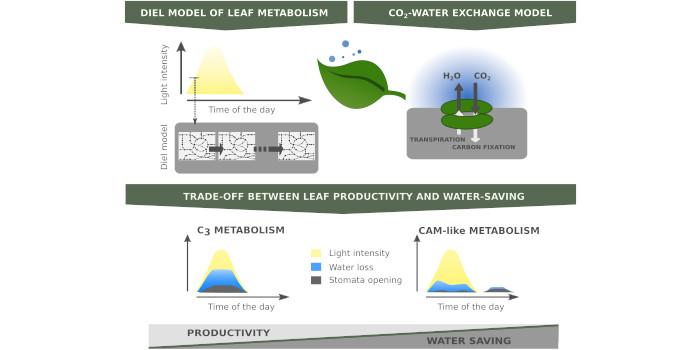
Credit: Toepfer/ IPK
During photosynthesis, plants take in CO2 from the environment and, with the help of sunlight, convert it into energy-rich sugars. CO2 uptake is regulated via the opening and closing of small pores on the leaf known as stomata. However, when stomata are open, water is lost from the plant through transpiration. Therefore, a balance must be struck between water loss and CO2 uptake. In C3 photosynthesis, the stomata open during the day when sunlight is available. This is energetically efficient, but results in significant water loss in environments with high daytime temperatures and low humidity. As an alternative, some plants can perform Crassulacean acid metabolism (CAM) photosynthesis, in which they open their stomata and temporarily fix CO2 at night when temperatures are lower and humidity is higher. They then release the fixed CO2 and refix it for sugar synthesis during the day while keeping the stomata closed. CAM photosynthesis is water-saving but less efficient.
To answer the question whether full CAM or alternative water-saving modes would be more productive in the environments typically experienced by C3 crops, the researchers coupled a day-night model of leaf metabolism and a gas-exchange model and performed simulations for a wide range of environments. Their results have recently been published in Plant Cell magazine.
“We found that, by running a partial CAM cycle, the plant could save more than 50% of its water while maintaining 80% of its maximum productivity in a temperate climate”, says Dr. Nadine Töpfer, head of the independent research group “Metabolic Systems Interactions” at IPK.
Moreover, the model identified an alternative CAM cycle involving the mitochondrial enzyme isocitrate dehydrogenase (ICDH) as a potential contributor to initial carbon fixation at night. “The additional water-saving effect of carbon fixation by ICDH can reach 11% of the total water saving for the conditions tested”, says Dr. Nadine Töpfer. “We also found that the CO2 storage capacity in the leaf vacuoles had a major effect on the extent of CAM and would need to be increased to establish a CAM cycle in C3 crops.”
In conclusion, the study demonstrates the water-saving potential of introducing CAM-like metabolism into C3 plants under a wide range of environmental conditions and suggests environment-specific engineering targets for improved drought resistance. Dr. Nadine Töpfer, who started the work during the tenure of a Marie-Curie Postdoctoral Fellowship in Professor Lee Sweetlove’s group in Oxford and completed it at IPK, says: “Modelling is a powerful tool for exploring complex systems and it provides insights that can guide lab and field-based work. I believe that our results will provide encouragement and ideas for the researchers who aim to transfer the water-conserving trait of CAM plants into other species.”
###
Media Contact
Dr. Nadine Toepfer
[email protected]
Related Journal Article
http://dx.




